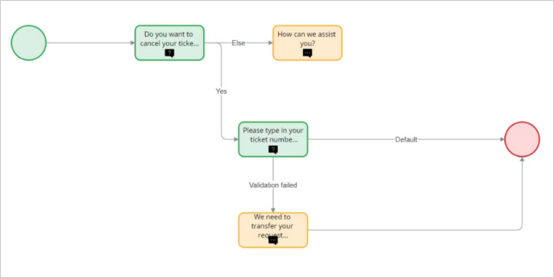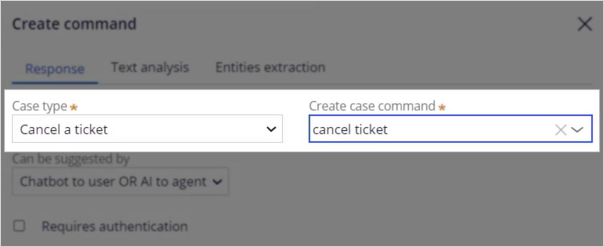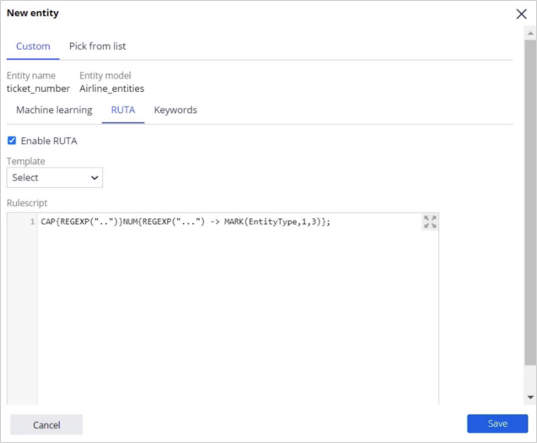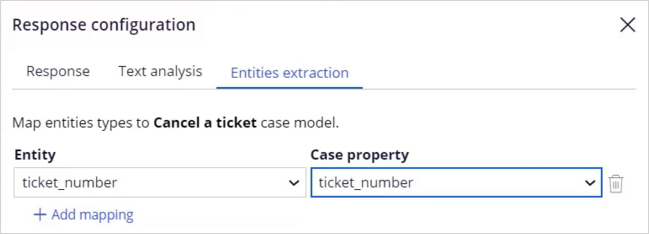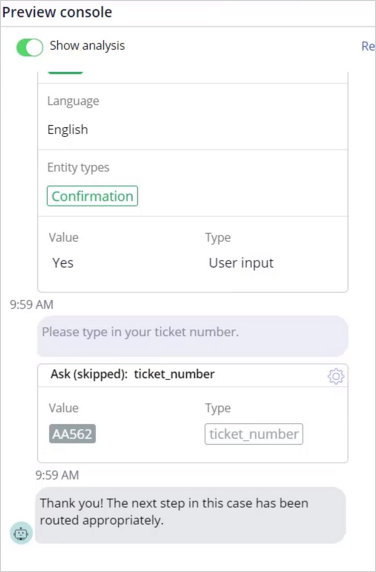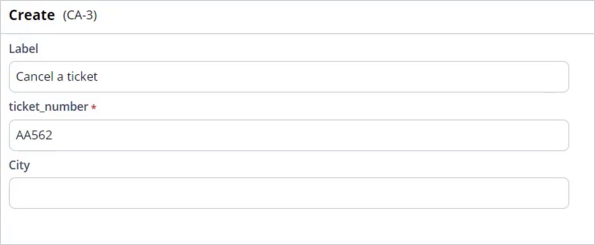
Training predictions for chatbot
Introduction
Web Chatbot is a feature in Pega Customer Service™ that allows your customers to enter questions or requests in a chat window that is accessible from a customer-facing web page, and then receive answers and guidance.
In a web chatbot session, the chatbot responds to a customer request, such as I want to cancel a ticket, by detecting the right topic with machine learning. The chatbot then walks the customer through a set of questions. The chatbot gathers the required information by leveraging entity extraction models. Learn how to train these topic detection and entity extraction models.
Video

Transcript
This demo shows you how to train a text prediction to enable the chatbot to handle ticket cancellation requests.
U+ Air uses machine learning to identify the topic of the incoming message and detect entities such as ticket numbers.
A text prediction that aims to detect the topic and entities included in the message drives the chatbot.
For example, when Troy, a customer, sends a message to the Airline chatbot that he wants to cancel his ticket, the text prediction detects the topic of the message and runs the Cancel a ticket case type that an application developer preconfigured in the system. The case type contains the conversation flow that the chatbot uses in conversation with Troy. Notice the conversation elements such as Ask a question or Send a message. Observe how the chatbot follows the conversation flow during interaction with Troy.
The prediction detects the ticket number entity that Troy provides, and then asks for confirmation.
Notice that the chatbot skips the Please type in your ticket number question because the text prediction detected that Troy provided the ticket number in the first message.
See how the chatbot reacts if Troy does not provide the ticket number in the first message.
Instead of skipping the question, the chatbot asks Troy to provide the ticket number.
Once the conversation ends, the chatbot saves the necessary information and routes the case to an appropriate Customer Service workbasket.
Note that the case contains the ticket number extracted by the text prediction during the conversation with Troy.
To make the chatbot available to customers, you first configure the digital messaging channel in App Studio.
Notice that the Cancel a ticket case type is specified. This is the same case type that contains the conversation flow that the chatbot uses in the conversation with Troy. The Create case command represents the topic in the text prediction. The chatbot triggers the case type creation when the text prediction detects this specific topic.
The topic detection and entities extraction are driven by a text prediction that is automatically generated after chatbot channel creation. Data scientist builds the models in the prediction in Prediction Studio. Models learn with training data. In this scenario, the training data contains three topics: action book ticket, action cancel ticket, and action reschedule. Besides topic detection models, the prediction contains entity extraction models that extract necessary information from the incoming chat message.
Notice the existing pySystemEntities model. It is an out-of-the-box entity extraction model that contains basic entities; you cannot modify it. To add a new entity type such as ticket number, you create a new entity extraction model.
After creation of the new model, you can create a new entity.
U+ Air determines that using Rule-based Text Annotation (Ruta) scripts is the best choice to detect the strict ticket number pattern. Ruta is a rule-based script language which detects keywords and phrases that follow specific patterns.
Notice the rulescript that detects the ticket number. This script detects ticket numbers that follow a strict pattern of two letters followed by three digits. In case of a rescheduled ticket or human error, the application also needs to detect unusual ticket number patterns. For example, a dash in between the letters and numbers, or three letters and three digits. Using Ruta with machine learning can achieve this business outcome.
A machine learning-based model must be built to enable machine learning entity extraction. You add training data to the ticket number entity to build the model; you can add training data one record at a time.
A training data record is a typical chat message that the customer sends. After adding a training data record, you manually identify the entities you want the model to recognize. In this case, JK-294 is a ticket number entity. Optionally, to improve the topic detection model, you can specify the topic of the message that provides additional training data.
You can also use a batch import from a dataset file to provide additional training data. Notice the tagging that identifies a specific entity in each record. It is possible to have multiple tags to train multiple entity types simultaneously.
After uploading the training data file, you can review each record and ensure that it was correctly imported. The correct ticket number entity and topic are flagged.
After uploading the dataset, build the models. Notice the New F-score for the Airline and Airline_entities models. Now, the entity extraction model can also detect unusual ticket number patterns.
To enable the chatbot to use the extracted entity in the created case, an application developer maps the entity to a case property in a case command.
The system uses this property in the Cancel a ticket case type.
With all models in the text prediction built, and all necessary properties mapped, it is possible to see in full detail how Pega natural language processing (NLP) works. The digital messaging interface has a built-in preview console that simulates the chatbot. After sending the I want to cancel my ticket number AA562 message, you can turn on the Show Analysis switch to see the chatbot details. In this case, the chatbot detects the topic of the message with 94% confidence. The confidence score, which is a value from 1 to 100, represents the confidence of the prediction. The chatbot detects the ticket number entity in the first message, skips the ticket number question, and then routes the case to a correct workbasket.
The case that the chatbot creates is available for review by the customer service representative in the CSR portal. Notice that because of the detected topic, the system creates a Cancel a ticket case. The case contains the ticket number extracted by the text prediction during the conversation with the customer.
You have reached the end of this video. What did it show you?
- How to create a chatbot channel.
- How to create a topic detection model.
- How to create an entity extraction model with machine learning and Ruta script.


